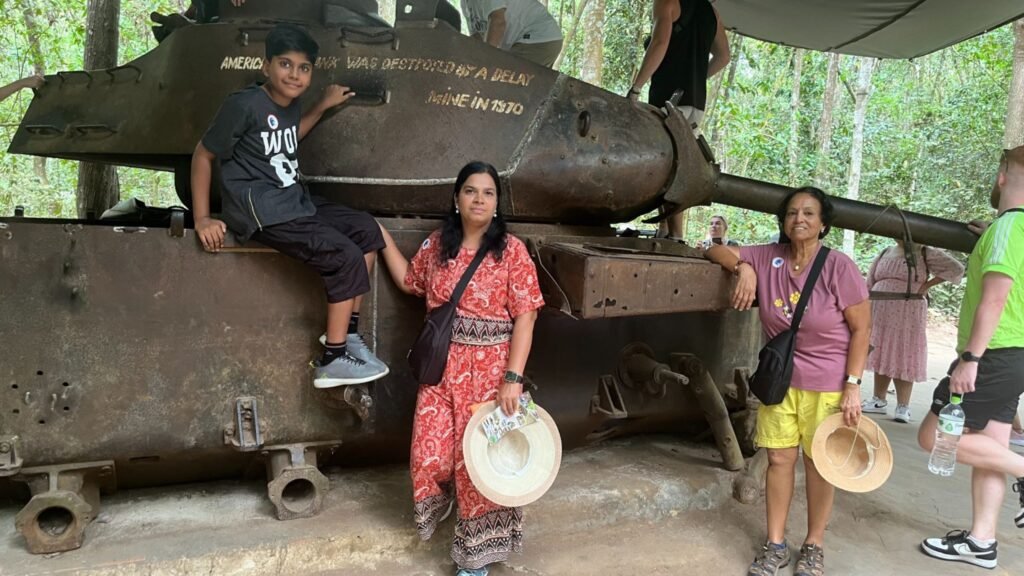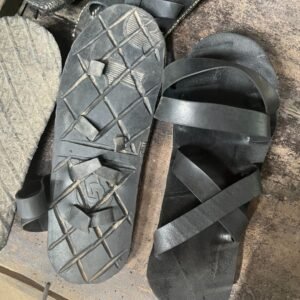Read this Cu Chi Tunnels, Vietnam travelogue written by Jayanthi Chandrasekaran. Get introduced to the amazing Cu Chi tunnels from the traveller’s point of view.

“Do you know the architect of these tunnels”, in his accented English, our guide posed the question. We were standing at the entrance to the Ben Dinh tunnel which is part of the Cu Chi tunnels located about 70 kms from Ho Chi Minh city (formerly Saigon) in Southern Vietnam. When we said ‘no’, he responded tongue in cheek, “Exactly”; he continued, “There was no blueprint, no engineers, no architects, just the tenacity and resilience of Vietnamese people”.

The Viet Minh soldiers, in the 1940s, built a network of tunnels in the Cu Chi district mainly hand-dug, with the use of bamboo baskets and garden spades to dispose of the debris. The 120km long tunnels under the jungle terrain of South Vietnam connected the villages and helped in troop movements in their fight against French colonial authorities. During the Vietnam-American war, to combat the superior firepower of American forces, the Viet Cong soldiers expanded the tunnel network from the Saigon River to the Cambodian border to accommodate facets of village life. Thus, the tunnels included kitchens, workshops, dormitories, conference rooms, infirmaries, toilets and so on at three different levels. They functioned as the living quarters as well as combat ground for the Viet Cong, apart from serving as communication and supply routes.
ALSO READ: Karwar, Where Time Stands Still

Today, the tunnels stand as the symbol of the tenacious spirit of Vietnamese soldiers. What they lacked in strength to face the superior firepower of Americans, they made up for in their spirit and ingenuity. Meals were cooked in the kitchen only at dawn so the smoke emerging from there would mingle with the morning mist. Termite mounds over the ground were used as exhaust. Air ventilation was given through the forest bushes. The tunnels were built in triangles, hence when the enemy started attacking one entrance they simply moved to another point of the triangle. The drainage system set up to save them from floods was so effective that when American troops flooded the tunnels they couldn’t flush the soldiers out.
ALSO READ: Neelambari – An Eco-Vacation in Arattupuzha

After the war ended in 1975, the unified Vietnam emerged and the tunnels were preserved, turned into a Memorial Park and were opened to tourists. The original tunnels were impossibly narrow to just fit the small-statured Viet Cong soldiers. Now they have been enlarged to accommodate tourists, yet they are tight and restrictive. There was a reality-check spot where the holes of actual size (35 X 25cm) had been dug and covered with a lid and camouflaged with leaves. It has become a perfect photo spot where tourists pose getting into the hole and pose with the lid up. When a chubby teenager in our group volunteered to get into the hole, our guide gently dissuaded her saying it was not a good idea.
The curated tour starts with a quick video in a hut about the Vietnam-American war. Our guide led us to the display of various traps set up by the Viet Cong members and passionately explained how they have only used simple Bamboo sticks and iron spikes in ingenious ways to wound or kill the enemy.
ALSO READ: Dudhsagar Falls: Nature’s Hidden Gem in Goa!

We also got to know about the difficult lives of men and women in the tunnels where air, food and water were scarce and infestation of insects, roaches, spiders, rats and snakes brought sickness. Malaria was the second biggest killer after battle wounds, we were told. The survivors were infected with intestinal parasites.

An American tank destroyed during the war was on display. The Viet Cong apparently blew it up with anti-tank mines. Ironically the traps were made using scraps from destroyed American artillery. Recycling was sustenance in the tunnel life. Even the discarded tire treads were used to make sturdy rubber slippers which were displayed.

During the last part of the tour, we were encouraged to explore a small part of the tunnel with a guide leading us into the scary space. Although the crouching and crawling lasted less than 10 minutes, it was claustrophobic and personally a terrifying experience for me.
A significant symbolism included at the end of the tour was a treat of Tapioca root and pandan tea which were the staple food for Viet Cong soldiers for the larger part of the war. Our guide did add a rider saying that the older generation of Vietnamese who survived the war totally excluded them from their diet. However, we found the tapioca root served with crushed peanuts-sugar on the side to be delicious.

Although our guide was relatively young and possibly second generation born after the war, we could feel the pain in his eyes and pride in his heart as he narrated the stories, which lingered in my mind long after the visit to the tunnels.
ALSO READ: Enchanting Cliffs in Emerald Isle – The Cliffs of Moher in Ireland!
